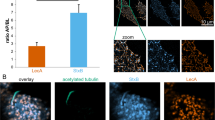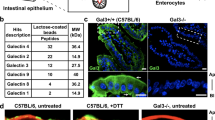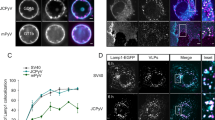Abstract
The binding of various biologically significant macromolecules to specific cell surface receptors is followed by their internalization, a process called receptor-mediated endocytosis1,2. In most cases, it has been shown that receptor-bound ligands cluster in characteristic, bristle-coated indentations of the cell surface known as coated pits1–3. In addition to coated pits, cultured cells have a population of smaller, non-coated membrane invaginations4–6, which may have a role in endocytosis2,7. However, no receptor-bound biologically active ligand has been shown to enter cells via these non-coated invaginations. The studies implicating coated pits in receptor-mediated endocytosis concern essentially ligands that bind to receptors thought to be glycoproteins. We have therefore investigated by electron microscopy the endocytosis of cholera toxin and tetanus toxin, ligands which bind to membrane glycolipids, in particular to either GM1 monosialoganglioside8–11 or di- and trisialogangliosides12–15 respectively. We show here that in cultured liver cells, non-coated membrane microinvaginations are preferentially involved in both the initial binding and subsequent internalization of colloidal gold-labelled cholera and tetanus toxin.
This is a preview of subscription content, access via your institution
Access options
Subscribe to this journal
Receive 51 print issues and online access
$199.00 per year
only $3.90 per issue
Buy this article
- Purchase on Springer Link
- Instant access to full article PDF
Prices may be subject to local taxes which are calculated during checkout
Similar content being viewed by others
References
Goldstein, J. L., Anderson, R. G. W. & Brown, M. S. Nature 279, 679–685 (1979).
Pastan, I. H. & Willingham, M. C. A. Rev. Physiol. 43, 239–250 (1981).
Pearse, B. M. F. & Bretscher, M. S. A. Rev. Biochem. 50, 85–101 (1981).
Anderson, R. G. W., Goldstein, J. L. & Brown, M. S. Proc. natn. Acad. Sci. U.S.A. 73, 2434–2438 (1976).
Röhlich, P. & Allison, A. C. J. ultrastruct. Res. 57, 94–103 (1976).
Orci, L. et al. Expl Cell Res. 113, 1–13 (1978).
Huet, C., Ash, J. F. & Singer, S. J. Cell 21, 429–438 (1980).
Holmgren, J. in Bacterial Toxins and the Cell Membrane (eds Jeljaszewicz, J. & Wadström, T.) 333–366 (Academic, London, 1978).
Brady, R. O. & Fishman, P. H. Adv. Enzymol. 50, 303–323 (1979).
Fishman, P. H. in Secretory Diarrhea (eds Field, M., Fordtran, J. S. & Schultz, S. G.) 85–126 (American Physiological Society, Bethesda, 1980).
Holmgren, J. Nature 292, 413–417 (1981).
Van Heyningen, W. E. Nature 249, 415–417 (1974).
Holmgren, J., Helwing, H., Fredman, P. & Svennerholm, L. Eur. J. Biochem. 106, 371–379 (1980).
Mellanby, J. & Green, J. Neuroscience 6, 281–300 (1981).
Rogers, T. B. & Snyder, S. H. J. biol. Chem. 256, 2402–2407 (1981).
Vergani, G., Pentz, S. & Herrmann, M. Virchows Arch. B-Cell Path. 31, 31–35 (1979).
Montesano, R. Anat. Rec. 198, 403–414 (1980).
Montesano, R., Perrelet, A., Vassalli, P. & Orci, L. Proc. natn. Acad. Sci. U.S.A. 76, 6391–6395 (1979).
Geoghegan, W. D. & Ackerman, G. A. J. Histochem. Cytochem. 25, 1187–1200 (1977).
Fishman, P. H. & Brady, R. O. Science 194, 906–915 (1976).
Critchley, D. R. & Vicker, M. G. in Dynamic Aspects of Cell Surface Organization (eds Poste, G. & Nicolson, G. L.) 307–370 (North-Holland, Amsterdam, 1977).
Yamakawa, T. & Nagai, Y. Trends biochem. Sci. 3, 128–131 (1978).
Schwab, M. E. & Thoenen, H. J. Cell Biol. 77, 1–13 (1978).
Joseph, K. C., Stieber, A. & Gonatas, N. K. J. Cell Biol. 81, 543–554 (1979).
Ackerman, G. A., Wolken, K. W. & Gelder, F. B. J. Histochem. Cytochem. 28, 1100–1112 (1980).
Bretscher, M. S., Thomson, J. N. & Pearse, B. M. F. Proc. natn. Acad. Sci. U.S.A. 77, 4156–4159 (1980).
De Bruyn, P. P. H., Michelson, S. & Becker, R. P. J. Cell Biol. 78, 379–389 (1978).
Frens, G. Nature phys. Sci. 241, 20–22 (1973).
Roth, J. & Binder, M. J. Histochem. Cytochem. 26, 163–169 (1978).
Author information
Authors and Affiliations
Rights and permissions
About this article
Cite this article
Montesano, R., Roth, J., Robert, A. et al. Non-coated membrane invaginations are involved in binding and internalization of cholera and tetanus toxins. Nature 296, 651–653 (1982). https://doi.org/10.1038/296651a0
Received:
Accepted:
Issue Date:
DOI: https://doi.org/10.1038/296651a0
Comments
By submitting a comment you agree to abide by our Terms and Community Guidelines. If you find something abusive or that does not comply with our terms or guidelines please flag it as inappropriate.



